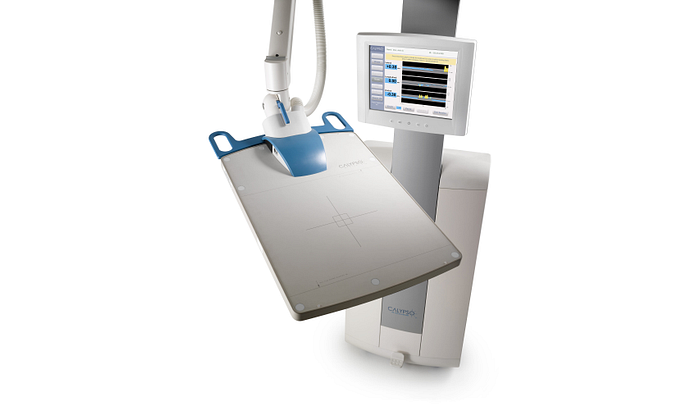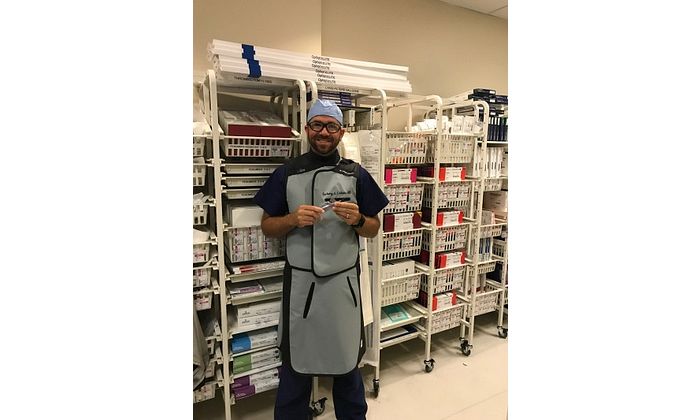When the University of Kansas Cancer Center (KUCC) decided to acquire Calypso technology roughly five years ago, the system already had a champion in Dr. Habeeb Saleh, Ph.D., DABR.

Dr. Saleh, the center’s chief of medical physics, had years of experience using Calypso in his previous position at the Medical College of Virginia. “It was only cleared for prostate back then,” he said. “But it was so effective that I kept following its development, knowing that a soft tissue application [for other types of cancer] was coming.”
When KUCC acquired a linear accelerator in 2013, Dr. Saleh—who had recently joined the center—requested that the purchase include Calypso. His colleague, Zachary Collins, M.D., also advocated for Calypso based on its growing word-of-mouth reputation and reported advantages for tumor tracking.
Zachary Collins, M.D., interventional radiologist at KUCC
“Up to that point, we’d been using gold or braided wire, simple fiducial markers,” said Dr. Collins, KUCC’s director of interventional radiology. "We were looking to really push the envelope with a real-time system like Calypso. Broadly speaking, the huge benefit of Calypso is the ability to perform 3D tracking in the region of interest, thereby minimizing collateral damage, side effects, and symptoms. Our previous technology simply couldn’t do that. I think that long-term, this will be a game-changer for radiation oncology and interventional radiology in general.”
Previously, Dr. Saleh had often used a respiratory gating system with an infrared reflector block as a surrogate for breathing-induced tumor motion. But Calypso tracks actual respiration in real time, an improvement Dr. Saleh likens to “working in the light versus working in the dark.”
“Now we can see the tumor motion in all three dimensions. You can say, ‘I need more tumor margin in the longitudinal direction than I need in the lateral direction.’ It’s absolutely intuitive,” says Dr. Saleh.
As an example, he offers prostate radiosurgery, where precise targeting is essential due to the prostate’s proximity to the rectum. “Calypso lets you minimize the potential for radiation to hit the rectum. So there’s less potential for rectal bleeding and discomfort for the patient. That’s a critical real-time benefit.”
In the earliest days of using Calypso, Dr. Collins, as an interventional radiologist, was primarily concerned with the placement of the transponder: could implantation be easy, accurate and atraumatic? “My first question was, are the needle cannulas stiff and steerable? The answer is yes. Getting the Calypso beacon to the right spot is actually quite straightforward.”
The use of Calypso has also helped deepen interdisciplinary relationships among clinicians at KUCC, in particular between the interventional radiology and the radiation oncology groups. “When we started doing prostate with Calypso, we had radiation oncologists placing the beacons,” said Dr. Saleh. “As a physicist, I was in the same room with them, giving feedback. Then, when we started doing liver and pancreas, I was reaching out to our interventional radiologists as well.”
Says Dr. Collins: “Radiation oncology has always been an independent entity, in some ways almost competitive with us. But Calypso has allowed us to collaborate more than ever before.”
The transition to Calypso at KUCC was a smooth one. Drs. Collins and Saleh largely credit the expertise and responsiveness of Varian representatives. “In terms of how to place the needles, how to space the Calypso beacons correctly, Varian was always there with support,” said Dr. Collins. “It was a very easy transition.”
“Varian was very helpful and generous in terms of being available," added Dr. Salah. "Whenever we needed Varian, they put people on a plane. They came.”
_______________________________________________________
The information captured herein represents the genuine experience of the attributed individuals and may not necessarily represent the views of Varian or the above referenced institution. Individuals were not compensated for their participation. Radiation treatment may not be appropriate for all cancers. Individual results may vary.
